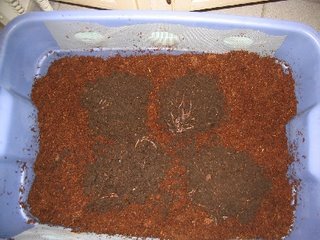I spent about 3 hours cooking last night: two types of zucchini bread, and stuffed zucchini rounds. Everything was experimental, and not everything turned out the way I had hoped (the low-fat raspberry-zucchini bread was particularly disappointing so I won't post a recipe for it). The garlic cheese zucchini bread, however, was excellent! I messed around with a recipe I found
here, and it was so easy I didn't even need a mixer.

Garlic Cheese Zucchini Bread
2 eggs
1 cup buttermilk
1/3 cup sugar
1/3 cup butter, melted
1 teaspoon salt
1/2 teaspoon baking powder
1/2 teaspoon baking soda
3 cups all-purpose flour
1 cup grated zucchini
1 tablespoon grated onion
2 cloves garlic, minced
1/2 cup grated sharp cheddar cheese
Beat together the eggs, buttermilk, sugar, and butter. Mix in the salt, baking powder, and baking soda. Mix in the flour until it's moist (don't over-mix).
Stir the garlic and onion into the zucchini, then fold the zucchini mixture into the batter. Stir in the cheese.
Pour into two 4 x 8 loaf pans, and bake at 350 for ~45 minutes, or until a toothpick comes out clean. The top will still be pale, or just slightly golden.
Stuffed zucchini rounds
My next experiment was another stuffed zucchini. I usually make a loose stuffing, browning some meat & onions, then adding to a grain of some sort (brown rice, bulgar, couscous, quinoa or whatever's on hand). This time I decided to go for more of a solid, meatloaf-type filling, and to cut the zucchini into rounds instead of lengthwise to make serving easier.
Consider this more of an idea than a recipe; I can't remember what all I used to spice it. As an afterthought, I added a garlic spice mix that I received in my last
Fair Share, and I didn't catch that the mix's top ingredient was salt. Because I had already done some seasoning, the result was way too salty.
1/2 to a whole large zucchini (depending on size)
1 pound ground buffalo (or ground beef)
1 medium onion
1 green pepper
olive oil
chicken broth
1-2 cups cups cooked quinoa, rice, or bulgar
1 egg
1 packet unflavored gelatin
seasoning to taste (use what you would for a meatloaf)
shredded cheddar
From a large zucchini, cut several ~2 inch rounds. Scoop out the center (save what you scoop out), place in a pan with a little chicken broth in the bottom, and bake at 350 for about 30 minutes or until the flesh is soft (not soggy).

Prepare the gelatin per package directions just prior to mixing the stuffing. If you prepare it too far in advance it'll be set up already, but you want it to be liquid.
Sautee the onion and pepper in a little olive oil. Dice the zucchini that was scooped from the rounds, along with any leftover zucchini that wasn't cut into rounds. Sautee with the onion/pepper mix. When stuffing a zucchini, I go ahead and sautee any squash that I have left. If it looks like too much, add to any leftover grain with a little cheese and some seasonings and cook it along with the stuffed zucchini.
Mix the raw ground meat, grains, seasoning, and sauteed vegetables in a large bowl. Add the egg, and add about 3 tablespoons of the prepared gelatin, which will keep the stuffing from drying out while cooking. Stuff the hollowed-out parts of the squash rounds, and form into a semi-circle on top.
Bake at 375 until a meat thermometer inserted into the stuffing reads 155. Start checking temperature after about 40 minutes. If the tops start to look dry, then cover loosely with foil.





















